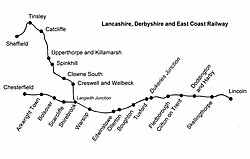|
Chesterfield Market Place railway station
   Chesterfield Market Place railway station was a former railway station in the centre of the town of Chesterfield, Derbyshire, England. Three stationsChesterfield Market Place station was the third and final station to be built in the town. Services from the first two, Chesterfield Midland (which remains open as "Chesterfield"), and Chesterfield Central (which closed in 1963) ran north–south, but those from Chesterfield Market Place ran to the east. HistoryOpeningThe station was opened as "Chesterfield" by the LD&ECR on 8 March 1897[3][1][4] and was the headquarters of the line. It was renamed "Chesterfield Market Place" on 1 January 1907.[1][4] The station was closed to passengers by BR on 3 December 1951[1][4] because of the prohibitive cost of maintaining and repairing Bolsover Tunnel, together with concerns over Doe Lea Viaduct and the limited amount of traffic. Goods services[5] continued until 4 March 1957.[6] Market Place station was situated on West Bars, adjacent to two old inns; the White Horse and the Bird in Hand. To take advantage of the additional custom generated by the railway, the owners of the White Horse, William Stones brewery of Sheffield, applied to build a new hotel. This was approved by the licensing magistrates in April 1898. As the licensing laws of the time prevented a pub from closing down during rebuilding, the new hotel was built in two parts. Building of the first phase commenced on the site of the Bird in Hand which had closed and had recently been demolished, its licence being transferred to the refreshment rooms in Market Place station. When the first part was complete the licence was transferred from the White Horse, along with the landlord, Job Siddall. The second phase was then erected on the site of the White Horse. The hotel, named after the Duke of Portland, on whose estate much of the railway ran, was officially opened Christmas 1899 by the Earl of Rosebery Archibald Primrose. LayoutThe station was a substantial three storey structure with a long glass awning,[7][8][9] it was quite unlike any other station on the line. Inside the station a glass-roofed concourse led to four curved platforms[10][11][12] on two islands - 1 & 2, 4 & 5. In the centre, in place of the missing platform 3, was a release line for the locomotives.[13][14][15][16][17] The adjacent goods depot was, at the time, the largest covered area in the town. Leaving the station, the line passed the Saxby and Farmer 80 lever station signal box,[18][19] crossed Park Road by an arched brick bridge then travelled along a short length of embankment followed by Boythorpe Viaduct which crossed the MR's Brampton Branch[20] and the industrial "Boythorpe Railway",[21] then a longer stretch of embankment leading to a major viaduct at Horns Bridge, which passed over the Midland Railway, main roads to Mansfield and Derby, the Great Central Railway, Hyde's Sidings and the River Rother. It consisted of seven brick arches and four girder spans, 63 feet high.[13] From there, the line climbed at 1 in 100 as far as the first summit at Duckmanton Tunnel, followed shortly by the station at Arkwright Town. OperationsUntil 1927, the station was also served by Chesterfield Tramway which ran from Brampton to Whittington. A dead end spur was built near the station and was situated on Market Place. At least one published photograph of the station shows the tramlines and overhead wires.[22] Passenger servicesChesterfield Market Place never had a Sunday service. In 1922, there were seven departures on Mondays to Fridays, with four extra on Saturdays. The weekday seven consisted of:
The Saturday extras consisted of one to Bolsover, one to Langwith Junction, later renamed Shirebrook North and two to Mansfield Central. A notable feature was the care taken to timetable services along the Beighton Branch to connect with Chesterfield services at Langwith Junction. At 10:44, for example, four trains would be standing at Langwith Junction:
Anyone catching the last weekday departure from Chesterfield, the 19:00 to Mansfield Central, could stay in his or her seat at Langwith Junction and arrive at Mansfield Central at 19:50 or change trains and arrive at Mansfield Town at 19:40.[23] More journey opportunities were added in 1925 when the service from Nottingham Victoria through Skegby and Pleasley East which since inception in 1901 had inexplicably terminated at Shirebrook South was extended the last mile to Shirebrook North. This was a forlorn gesture, as the service was withdrawn throughout in 1931.[24] The intersecting services along the Beighton Branch were withdrawn on the outbreak of the Second World War with Mansfield Central services ending by 1945, leaving Chesterfield Market Place with two all stations trains to Lincoln plus some shorter workings to Shirebrook North and to Bolsover.[25] ClosureIn August 1948, its unused track and space was put to work to house the Stephenson Centenary Exhibition of locomotives and rolling stock. [26][27][28] As a last hurrah, special trains were run to the coast shortly before the station closed to passengers on 3 December 1951.[29] After closure to passengers, the tracks into the platforms were lifted[30] and the line to Arkwright Town was singled and operated on the "one engine in steam" basis. This was perfectly adequate for the single daily freight train from Staveley.[31][32] This ended in March 1957. From some point between 1951 and 1956, the station building became used by Charles Credland Ltd, a paint and wallpaper firm,[3] which continued until demolition. Tracks were lifted in 1957/8 when the bridge over Park Road was demolished using explosives.[33]
Present dayThe station was demolished in April 1973[34] and, following considerable redevelopment of the area,[35] it has now been built upon. The current building occupying the space is Future Walk, the finance headquarters for the Post Office. A few signs of the old embankment can still be seen at the bottom of the car park. See alsoReferencesNotes
Sources
Further reading
External links
|
|||||||||||||||||||||||||||||||||||||||||||||||||||||||||||||||||||||||||||||||||||||||||||||||||||||||||||||||||||||||||||||||||||||||||||||||||||||||||||||||||||||||||||||||||||||||||||||||||||||||||||||||||||||||||||||||||||||||||||||||||||||||||||||||||||||||||||||||||||||||||||||||||||||||||||||||||||||||||||||||||||||||||||||||||||||||||||||||||||||||||||||||||||||||||||||||||||||||||||||||||||||||||||||||||||||||||||||||||||||||||||||||||||||||||||||||||||||||||||||||||||||||||||||||||||||||||||||||||||||||||||||||||||||
Portal di Ensiklopedia Dunia
